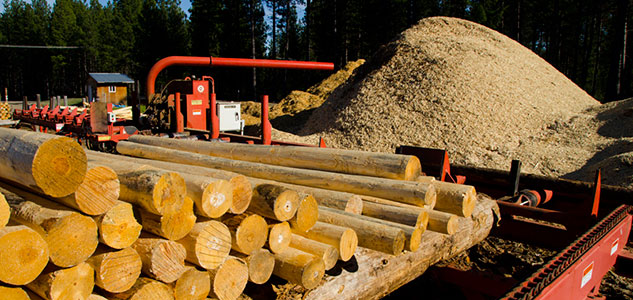We believe that rural communities have been given a false choice between jobs and the natural environment. Our economic development work seeks to create economic opportunity and promote the health of local forests.

Meeting Nature’s Needs
In the Mt. Adams region, many forests are characterized by an overabundance of small diameter trees relative to historic conditions. These lands are slower to develop wildlife habitat and ecosystem functions characteristic of older, more mature forests–which are lacking across our landscape. They’re also at higher risk of disease, drought damage, and wildfire due to high competition for limited resources.
In our fire dependent ecosystems, these conditions historically would not prevail. Wildfire reduced tree densities by killing young saplings and acting as a natural thinning agent. Due to the high cost and risk of unintended mortality, however, prescribed burning is not viable for most landowners. Mechanically reducing tree densities is often landowners’ only option for restoring essential ecological processes.
Creating Local Markets
Restoration of forest health through logging, thinning, and piling is also costly. So one of the primary objectives of our economic development work is to support market development for the small, low value trees coming from these activities. Small diameter log markets can reduce restoration treatment costs for landowners by providing a modest income for material that would normally only be a cost. At the same time, markets create manufacturing employment opportunities within our communities. Local jobs reduce long commutes, save fuel, and allow families to stay closer to home. Our work takes a triple bottom line approach to economic development–one that provides cleaner air, healthier forests, and economic opportunity.
Small Wood Utilization Initiative
The Small Wood Utilization Initiative represents a comprehensive effort to support job growth and forest health.
The InitiativePromoting the development of local markets for small diameter logs and woody biomass starts at the forest level, with collaboratively planned comprehensive projects that focus on stewardship of both public and private resources, and ends with successful marketing of forest restoration byproducts. There are clearly many steps in between, including harvesting and transportation, primary manufacturing, and research and development of emerging technologies. This work integrates all of our program areas but rests on successfully coordinating short and long-term planning efforts; establishing strong, stable log purchasing businesses; and solid partnerships with area contractors.
Business Incubator and Log Yard
Providing tools to entrepreneurs who create markets for restoration-derived logs.
Creating OpportunityIn 2008 MARS opened the gates to an integrated log utilization center in the Glenwood Valley. With initial support from Klickitat County, US Forest Service, US Department of Agriculture, and WA Department of Natural Resources, the site has hosted several start-up companies working to utilize small diameter logs as their primary feedstock. These have included post and pole manufacturing and a commercial firewood production. Additional products from operations have included wood mulch and hog fuel. The 10 acre log yard offers access to a certified truck scale, water, manufacturing and handling equipment at affordable rates, and close proximity to over 50,000 acres of mixed ownership commercial timberland. New businesses often have non-physical needs as well, so we offer a range of product marketing, feedstock acquisition, and planning services to help businesses get off the ground. We are actively seeking new businesses and product lines that fit within the log yard’s integrated utilization model.
